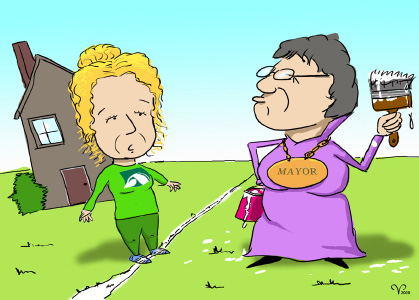Regional council’s informal position

G-Spot: Curiously, Rodney District Council’s proposal for a rural ward placed the boundary immediately north of regional councillor Christine Rose’s residence—even a district councillor, Pat Delich, said it looked like a gerrymander. The otherwise inexplicable boundary proposal ultimately failed. cartoon Majorlook Productions
The Auckland Regional Council respects and commends the NZ Transport Agency’s concern over growth pressures arising from transport infrastructure, and the need to reinforce and recognize the regional growth strategy etc as signalled in the regional policy statement.
The regional council’s initial concerns with ramps relate to three main areas
- The integrity of regional planning
- Growth pressures
- Physical impacts of access.
Regional Planning
The regional policy statement recognizes that transport infrastructure should reinforce planned growth identified in the regional growth strategy and district plan, but it also recognizes that efficient transport infrastructure is vital to the prosperity and wellbeing of region and its people. The policy statement therefore doesn’t strongly justify removal of motorway access to control growth, and the argument for denying motorway access to control growth based on the statement may not withstand an Environment Court challenge.
Growth Pressures
We are all unified in the desire to protect this area’s natural and cultural qualities from unintended growth pressures.
However, the real future development pressure and potential has not been quantified (noting geological constraints), and at the same time it’s clear that the district plan, (and the Environment Court) already allow significant hinterland development. With a 50% increase in population in the area in the last five years perhaps stimulated by the current motorway access, we can’t afford to wait another 10 years to try to grapple with the issue, by simply removing the current level of motorway access. We have to deal with growth pressures now.
In fact to avoid development and growth pressures in the meantime, we’d suggest the NZ Transport Agency, the councils and the community should work on how planning protection can be strengthened in the face of current pressures. This is a matter for the here and now, not just in 10 years time when the motorway extension is built.
We also all need to consider that the traffic impacts from all the current and future permitted development potential will need to be mitigated, and retaining access to the motorway might well the most be sustainable option for this, rather than funnelling it all through the old State Highway 1 and Ōrewa.
The Auckland Regional Council and Regional Transport Committee support investigation into better connections between the Auckland and Northland regions, and given the long life of this planned infrastructure it would be short sighted and foolhardy to not consider and plan for access to this area—even while recognising it’s an area where ‘development is to be avoided’ (Regional Policy Statement: Plan Change 6), clearly development is occurring in the wider hinterland area which will be making use of the current motorway access for the next 10 years, and which will need to be managed in the future. The regional council generally supports future-proofing transport infrastructure, and not foreclosing options.
Physical impact of ramps
The regional council has statutory responsibilities for managing cultural and natural heritage and outstanding natural landscapes. We take these very seriously and can not and would not resile from them. However, we need more analysis and information to identify what the effects of the motorway and any ramps might be, and to determine what action might be required to avoid, remedy or mitigate these effects. We can’t make these assessments until more work is done (specifically on where ramps might go), though we are awaiting advice from staff based on what information is available for the proposed motorway alignment.
Summary
Auckland Regional Council (and clearly everyone else) has concerns about growth pressures. The debate here is about removing existing motorway access, not the provision of new. The regional policy statement is open to interpretation, and we need more information to make an informed decision about direct impacts from the motorway and ramps. Potential impacts are all unknown at present.
Recommendations
- That the NZ Transport Agency provides for ramps in its plans for the new motorway, so as to manage current and medium term traffic demands from the wider mid-Rodney area, to not foreclose future options, and to enable further assessment of effects (in consultation with the community and the councils). The transport agency should compare this with their current counterfactual case; a motorway without access at Pūhoi–Mahurangi West, and also with plans showing only selected improvements to the existing State Highway 1 for safety and congestion purposes including by-passes of Warkworth and Wellsford. This way everyone can make a well-informed choice with a commensurate amount of information available in a way that preserves more options and flexibility for the longer term.
- The transport agency should investigate thoroughly the wider traffic network impacts from the proposal to remove current motorway access (including traffic volumes and impacts on the safe operation of the existing State Highway 1 and through Ōrewa). An assessment should also be done on the economic implications for Pūhoi should access be removed.
- The agency should proceed with ongoing consultation with the community and relevant agencies to quantify and manage current and medium term growth pressures arising from the current motorway access.
